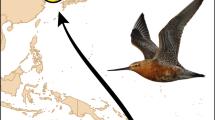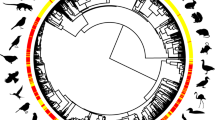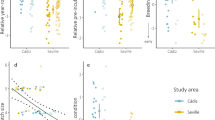Abstract
Predicting the range of variation over which organisms can adjust to environmental change is a major challenge in ecology1,2. This is exemplified in migratory birds which experience changes in different habitats throughout the annual cycle3. Earlier studies showed European population trends declining strongest in migrant species with least adjustment in spring arrival time4,5. Thus, the increasing mismatches with other trophic levels in seasonal breeding areas6,7 probably contribute to their large-scale decline. Here we quantify the potential range of adjusting spring arrival dates through modifying migration speeds by reviewing 49 tracking studies. Among-individual variation in migration speed was mainly determined by the relatively short stop-over duration. Assuming this population response reflects individual phenotypic plasticity, we calculated the potential for phenotypic plasticity to speed-up migration by reducing stop-over duration. Even a 50% reduction would lead to a mere two-day advance in arrival, considering adjustments on the final 2,000 km of the spring journey. Hence, in contrast to previous studies8,9,10, flexibility in the major determinant of migration duration seems insufficient to adjust to ongoing climate change, and is unlikely to explain some of the observed arrival advancements in long-distance migrants.
This is a preview of subscription content, access via your institution
Access options
Access Nature and 54 other Nature Portfolio journals
Get Nature+, our best-value online-access subscription
$29.99 / 30 days
cancel any time
Subscribe to this journal
Receive 12 print issues and online access
$209.00 per year
only $17.42 per issue
Buy this article
- Purchase on Springer Link
- Instant access to full article PDF
Prices may be subject to local taxes which are calculated during checkout


Similar content being viewed by others
References
Walther, G.-R. et al. Ecological responses to recent climate change. Nature 416, 389–395 (2002).
Visser, M. E. Keeping up with a warming world; assessing the rate of adaptation to climate change. Proc. R. Soc. B 275, 649–659 (2008).
Both, C. Flexibility of timing of avian migration to climate change masked by environmental constraints en route. Curr. Biol. 20, 1–6 (2010).
Møller, A. P., Rubolini, D. & Lehikoinen, E. Populations of migratory bird species that did not show a phenological response to climate change are declining. Proc. Natl Acad. Sci. USA 105, 16195–16200 (2008).
Newson, S. E. et al. Long-term changes in the migration phenology of UK breeding birds detected by large-scale citizen science recording schemes. Ibis 158, 481–495 (2016).
Both, C., Bouwhuis, S., Lessells, C. M. & Visser, M. E. Climate change and population declines in a long-distance migratory bird. Nature 441, 81–83 (2006).
Both, C. et al. Avian population consequences of climate change are most severe for long-distance migrants in seasonal habitats. Proc. R. Soc. B 277, 1259–1266 (2010).
Knudsen, E. et al. Challenging claims in the study of migratory birds and climate change. Biol. Rev. 86, 928–946 (2011).
Tarka, M., Hansson, B. & Hasselquist, D. Selection and evolutionary potential of spring arrival phenology in males and females of a migratory songbird. J. Evol. Biol. 28, 1024–1038 (2015).
Charmantier, A. & Gienapp, P. Climate change and timing of avian breeding and migration: evolutionary versus plastic changes. Evol. Appl. 7, 15–28 (2014).
Stephens, P. A. et al. Consistent response of bird populations to climate change on two continents. Science 352, 84–87 (2016).
Saino, N. et al. Climate warming, ecological mismatch at arrival and population decline in migratory birds. Proc. R. Soc. B 278, 835–842 (2011).
Sergio, F. et al. Individual improvements and selective mortality shape lifelong migratory performance. Nature 515, 410–413 (2014).
Gwinner, E. Circadian and circannual programmes in avian migration. J. Exp. Biol. 199, 39–48 (1996).
Jonzén, N. et al. Rapid advance of spring arrival dates in long-distance migratory birds. Science 312, 1959–1961 (2006).
Alerstam, T. & Lindström, Å. in Bird Migration: Physiology and Ecophysiology (ed. Gwinner, E.) 331–351 (Springer, 1990).
Nilsson, C., Klaassen, R. H. G. & Alerstam, T. Differences in speed and duration of bird migration between spring and autumn. Am. Nat. 181, 837–845 (2013).
Stanley, C. Q., MacPherson, M., Fraser, K. C., McKinnon, E. A. & Stutchbury, B. J. M. Repeat tracking of individual songbirds reveals consistent migration timing but flexibility in route. PLoS ONE 7, e40688 (2012).
Tøttrup, A. P. et al. Drought in Africa caused delayed arrival of European songbirds. Science 338, 1307 (2012).
Conklin, J. R., Battley, P. F. & Potter, M. A. Absolute consistency: individual versus population variation in annual-cycle schedules of a long-distance migrant bird. PLoS ONE 8, e54535 (2013).
Studds, C. E. & Marra, P. P. Rainfall-induced changes in food availability modify the spring departure programme of a migratory bird. Proc. R. Soc. B 278, 3437–3443 (2011).
Thackeray, S. J. et al. Phenological sensitivity to climate across taxa and trophic levels. Nature 535, 241–245 (2016).
Charmantier, A. et al. Adaptive phenotypic plasticity in response to climate change in a wild bird population. Science 320, 800–803 (2008).
Both, C., van Asch, M., Bijlsma, R. G., van den Burg, A. B. & Visser, M. E. Climate change and unequal phenological changes across four trophic levels: constraints or adaptations? J. Anim. Ecol. 78, 73–83 (2009).
Bauer, Z. et al. Changing climate and the phenological response of great tit and collared flycatcher populations in floodplain forest ecosystems in Central Europe. Int. J. Biometeorol. 54, 99–111 (2010).
Deppe, J. L. et al. Fat, weather, and date affect migratory songbirds’ departure decisions, routes, and time it takes to cross the Gulf of Mexico. Proc. Natl Acad. Sci. USA 112, E6331–E6338 (2015).
Jonzén, N., Hedenström, A. & Lundberg, P. Climate change and the optimal arrival of migratory birds. Proc. R. Soc. B 274, 269–274 (2007).
Van Buskirk, J., Mulvihill, R. S. & Leberman, R. C. Phenotypic plasticity alone cannot explain climate-induced change in avian migration timing. Ecol. Evol. 2, 2430–2437 (2012).
Zwarts, L., Bijlsma, R. G., van der Kamp, J. & Wymenga, E. Living on the Edge: Wetlands and Birds in a Changing Sahel (KNNV Uitgeverij, 2009).
Harrison, X. A., Blount, A. D., Inger, R., Norris, D. R. & Bearhop, S. Carry-over effects as drivers of fitness differences in animals. J. Anim. Ecol. 80, 4–18 (2011).
Rakhimberdiev, E. et al. Comparing inferences of solar geolocation data against high-precision GPS data: annual movements of a double-tagged black-tailed godwit. J. Avian Biol. 47, 589–596 (2016).
R Core Team R: A Language and Environment for Statistical Computing (2015).
Korner-Nievergelt, F. et al. Bayesian Data Analysis in Ecology Using Linear Models with R, BUGS, and Stan (Elsevier, 2015).
Gelman, A. & Hill, J. Data Analysis using Regression and Multilevel/Hierarchical Models (Cambridge Univ. Press, 2007).
Johnson, P. C. D. Extension Nakagawa & Schielzeth’s R2GLMM to random slopes models. Methods Ecol. Evol. 5, 944–946 (2014).
Acknowledgements
We thank R. G. Bijlsma in sharing his excellent arrival data and A. Kölzsch for providing migration data of greater white-fronted geese. H.S. is funded by the Deutsche Forschungsgemeinschaft (DFG, German Research Foundation)—SCHM 2647/1-2.
Author information
Authors and Affiliations
Contributions
H.S. designed the study. H.S. analysed the tracking data and modelled the phenotypic response. C.B. analysed the phenology data. H.S. and C.B. wrote the paper.
Corresponding author
Ethics declarations
Competing interests
The authors declare no competing financial interests.
Supplementary information
Supplementary Information
Supplementary Information (PDF 423 kb)
Supplementary Information
Supplementary Information (ZIP 3 kb)
Rights and permissions
About this article
Cite this article
Schmaljohann, H., Both, C. The limits of modifying migration speed to adjust to climate change. Nature Clim Change 7, 573–576 (2017). https://doi.org/10.1038/nclimate3336
Received:
Accepted:
Published:
Issue Date:
DOI: https://doi.org/10.1038/nclimate3336
This article is cited by
-
Individuals departing non-breeding areas early achieve earlier breeding and higher breeding success
Scientific Reports (2024)
-
The oxidative balance and stopover departure decisions in a medium- and a long-distance migrant
Movement Ecology (2023)
-
Migrating mule deer compensate en route for phenological mismatches
Nature Communications (2023)
-
Spring phenology is advancing at a faster rate than arrival times of Common Starling
Journal of Ornithology (2023)
-
Across the deserts and sea: inter-individual variation in migration routes of south-central European barn swallows (Hirundo rustica)
Movement Ecology (2022)



